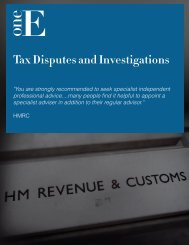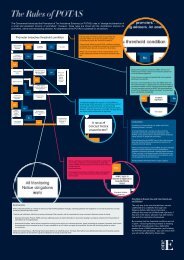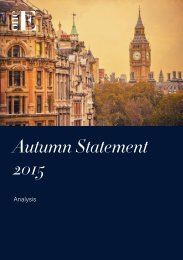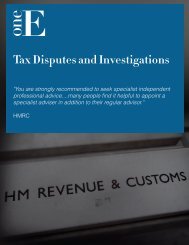Change to taxation of Landlords
You also want an ePaper? Increase the reach of your titles
YUMPU automatically turns print PDFs into web optimized ePapers that Google loves.
Example<br />
Additional Rate – Alex’s Position from 2020<br />
Alex, the landlord, still pays tax at the<br />
additional rates on his highly leveraged<br />
portfolio.<br />
The new rules on the rules on<br />
deductibility <strong>of</strong> finance costs are now<br />
fully in place (i.e. from 2020-21 onwards),<br />
but no changes were made by Alex <strong>to</strong><br />
adapt:<br />
Rent:<br />
Mortgage:<br />
£ 200,000<br />
£(150,000)<br />
As a result <strong>of</strong> these new rules, Alex’s<br />
property portfolio, which was previously<br />
pr<strong>of</strong>itable, now makes a loss <strong>of</strong> £10,000<br />
p/a.<br />
Insufficient income is retained after tax <strong>to</strong><br />
make the mortgage payments, putting<br />
the landlord in a precarious position. This<br />
simple scenario highlights how the<br />
changing tax context may affect the<br />
viability <strong>of</strong> property investments unless<br />
steps are taking <strong>to</strong> adjust <strong>to</strong> these<br />
changes.<br />
Tax Liability at 45%*:<br />
Rental Pr<strong>of</strong>its:<br />
£ (60,000)<br />
£ (10,000)<br />
* The tax calculation is now a little more<br />
complicated. We first look treat the entire<br />
rent as assessable on Alex (i.e. £200,000<br />
@ 45% = £90,000) and deduct tax relief<br />
on the mortgage payments as a “tax<br />
reducer” at basic rate (£150,000 @ 20%<br />
= £30,000), leaving a tax liability <strong>of</strong><br />
£60,000.












